Looking to really reduce your AR double-tap times?
You’ll want to go the lightweight low-mass bolt carrier group (BCG) route.
The BCG is the piece of metal moving back and forth between each shot. Lower the weight…and you’ll lower the disturbance to your rifle and sight picture.
We’ll cover the most popular ones out right now, other upgrades you should do at the same time, and reliability concerns.
Sneek peak, here are our top picks for lightweight BCGs:
THE QUICK LIST
-
Lightest BCG
-
Most Affordable
-
Editor’s Choice
Table of Contents
Loading…
Why Get a Lightweight BCG?
As we mentioned above…lowering the mass of the primary thing moving around in your rifle is going to help minimize the overall movement.
This will let you get back on target faster and reduce the felt recoil.
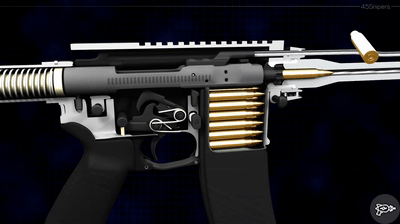
The normal advice is to use the full-auto (FA) BCG compared to the lighter semi-auto BCG when used in rifles where reliability is key.
And don’t worry…full-auto BCG’s are perfectly legal. It’s the trigger group that makes something actually full-auto.
The extra mass of FA BCG’s keeps things running smoothly in over-gassed AR-15’s that were made to run a variety of ammo and in crappy environments.
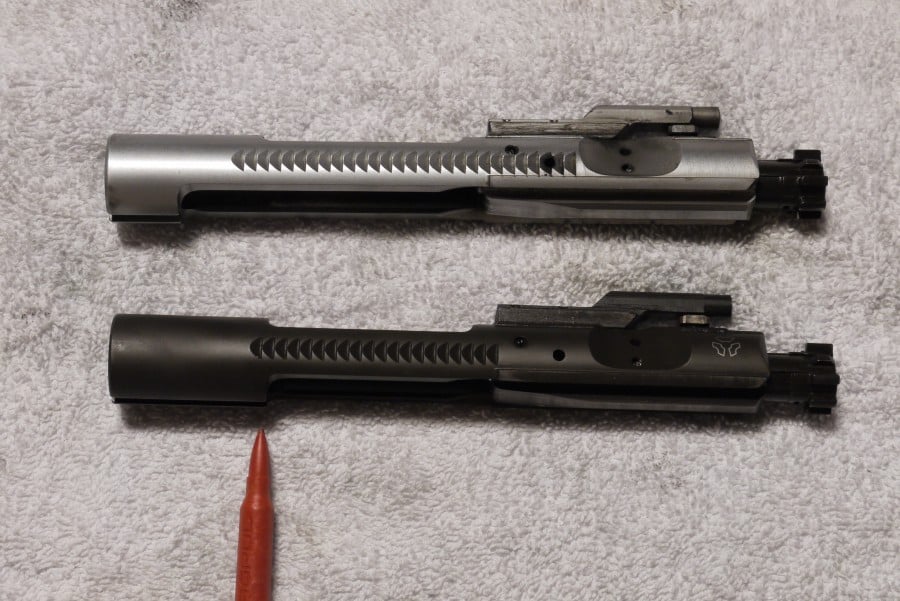
Since you’re looking at lightweight BCG’s…you’re probably messing around with a secondary AR-15…likely for competition.
You probably won’t be scrounging for ammo on the battlefield so you can lower the amount of mass needed to make your rifle still run 100%.
I know what you’re thinking…
What about using the lighter semi-auto BCG?
It’s only slightly less weight at 10 oz and change compared to the FA of 11.5 oz…while the ones we’re going to talk about are getting down to the 5 oz range.
How Do You Lower the Mass of BCG’s?
First…you can cut away “unnecessary” parts of the steel carrier.
And second…you can use more exotic materials that weigh less.
You’ll see a mixture of these two types of mass lowering techniques in our roundup.
Speaking of which…let’s get started!
Best Lightweight BCGs
We’ve tried out three of the most popular ones on the market…
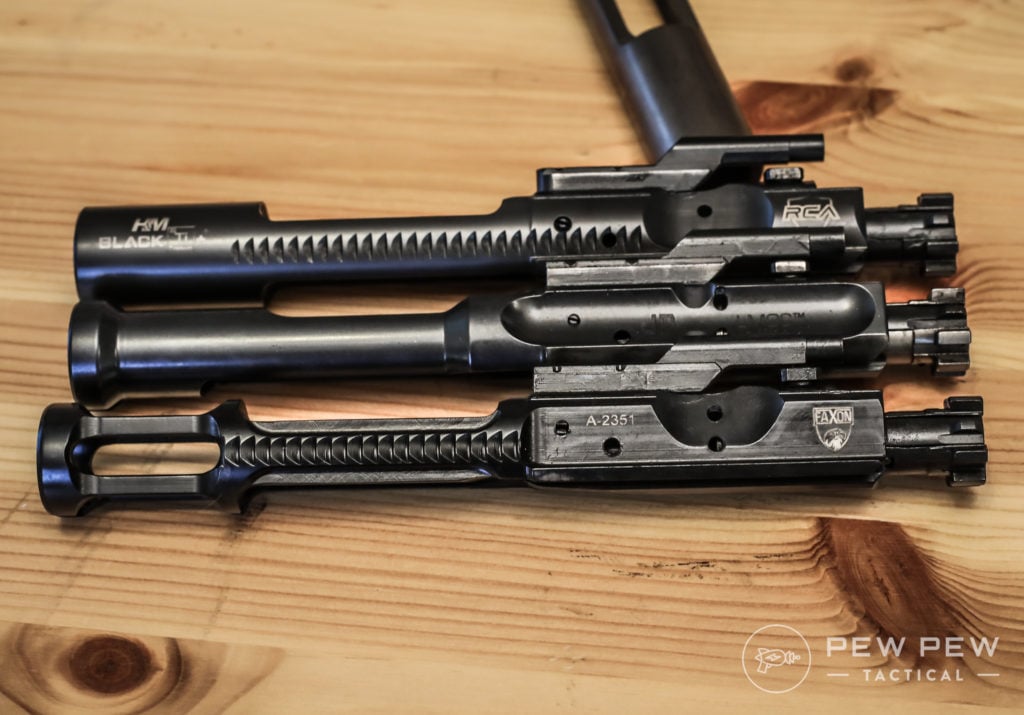
1. JP Enterprises Low Mass (LMOS) BCG
Prices accurate at time of writing
Prices accurate at time of writing
-
25% off all OAKLEY products - OAKLEY25
Copied! Visit Merchant
- Weight: 8.9 oz
- Price: $335
- Material: Steel
- Notes: No serrations for use of the forward assist
JP was one of, if not the first, major company to sell lightweight BCGs. For a while, they stopped, but now they are back at it again with their Low Mass Operating System (LMOS) models.
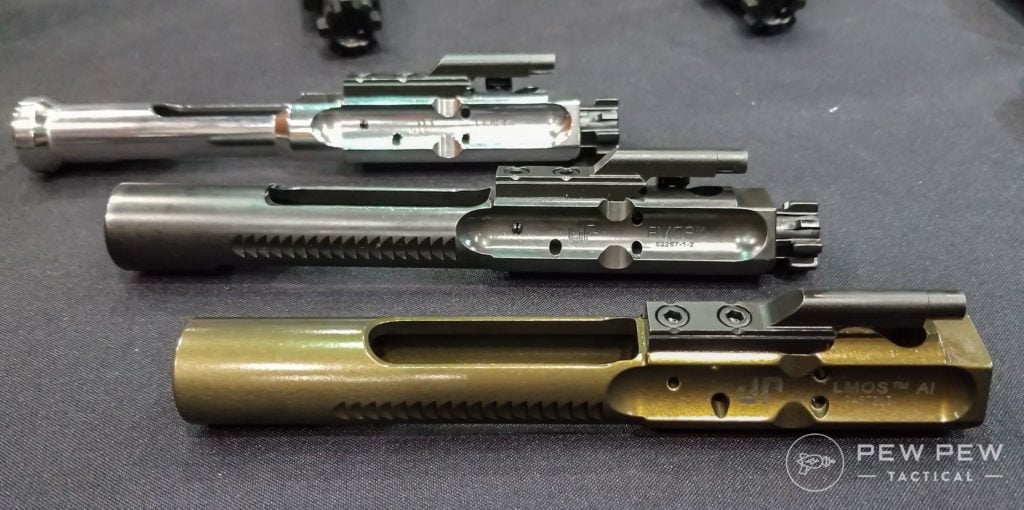
We’re at around the 1000 round count and don’t see any major wearing…just sweet low recoil shooting. It’s made of steel so it should keep on chugging.
Just keep in mind that you’ll lose the use of your forward assist function (who has ever actually used their forward assist though?).
*EDIT* I originally stated that this model was aluminum.
2. JP Enterprises Ultra Low Mass BCG
Prices accurate at time of writing
Prices accurate at time of writing
-
25% off all OAKLEY products - OAKLEY25
Copied! Visit Merchant
- Weight: 5.8 oz
- Price: $437
- Material: Aluminum
- Notes: Lightest BCG on the market today
This new BCG from JP recently came out so we haven’t gotten our mitts on it yet…but we had to include it since it truly is ULTRA low mass.
But with great weight reduction comes great cost.
Both monetarily and reduced life. Because the BCG is the same material as your upper receiver (aluminum)…it will see some wear and degradation as it does its job…to a point where you have to get a new one. For that reason, JP recommends that you use the Ultra only in competition rifles.
It now has forward assist capabilities, but after a couple thousand rounds you’ll have to junk it for a new one.
3. Faxon Lightweight BCG
Prices accurate at time of writing
Prices accurate at time of writing
-
25% off all OAKLEY products - OAKLEY25
Copied! Visit Merchant
- Weight: 8.5 oz
- Price: $249
- Material: Steel
From Faxon, maker of affordable and great barrels comes their lightweight steel BCG. Check out all of those weight reducing cuts!
Since it’s steel…the carrier should last almost indefinitely like its semi and full-auto brethren.
We’ve been running it in our overall super lightweight build for around 800 rounds and it’s been running smooth as butter.
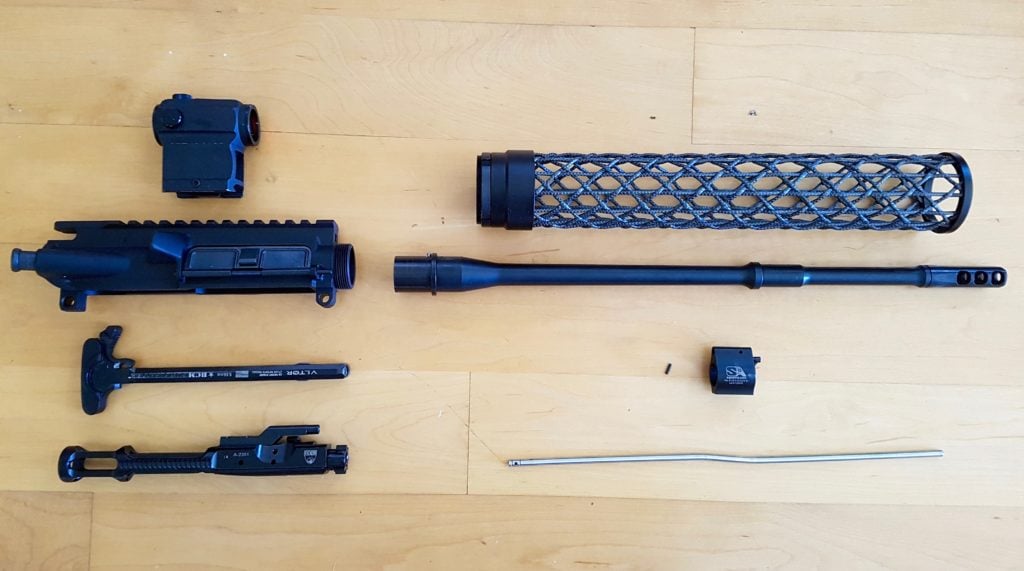
The price is right too at about $200 less than the normal JP aluminum BCG and even less weight. Just good luck finding it in stock!
4. JP Enterprises LMOS Steel Carrier
Prices accurate at time of writing
Prices accurate at time of writing
-
25% off all OAKLEY products - OAKLEY25
Copied! Visit Merchant
- Weight: 8.8 oz (with bolt)
- Price: $215
- Material: Steel
- Notes: Carrier only…you’ll need a bolt from somewhere else, plus no forward assist serrations
Since at the time of publication the Faxon was sold out everywhere…I’m throwing in JP’s steel version for price-conscious lightweight aficionados.
The weight is on par and you’ll save if you scrounge up a bolt from a previous BCG.
5. Rubber City Armory (RCA) Titanium BCG
Prices accurate at time of writing
Prices accurate at time of writing
-
25% off all OAKLEY products - OAKLEY25
Copied! Visit Merchant
Thank you, titanium, for bringing the best of both worlds…the lightness of aluminum but the durability of steel.

- Weight: 7.8 oz (with bolt)
- Price: $360
- Material: Titanium
You’ll shave off 32% of the weight compared to a standard BCG, but you won’t run into the wear problems of aluminum carriers.
I’ve been running the RCA for over a year (estimate 2500 rounds) in my competition build and I’m still not tired of tapers showing me the touching double-taps I get on targets.
6. Brownells Lightweight BCG
A newcomer from Brownells which usually has great self-branded stuff. When you want to try out going lightweight without breaking the bank.
Comes in three flavors of Nitride, Nickel Boron (my recommendation), or TiN (gold…yea you know who you are).
Prices accurate at time of writing
Prices accurate at time of writing
-
25% off all OAKLEY products – OAKLEY25
Copied! Visit Merchant
What Other Mods?
Since the AR-15 is a well-oiled machine where multiple parts have to work together…you can’t just change up 30% of one thing without having to mod others.
Here’s what I found to have the best reliability combined with a lighter BCG.
JP Captured Spring
Prices accurate at time of writing
Prices accurate at time of writing
-
25% off all OAKLEY products – OAKLEY25
Copied! Visit Merchant
Gets rid of the *sproing* of the regular buffer tube spring…and makes your AR-15 feel and shoot SO much better. Especially needed since the standard buffer and spring are too heavy/stiff for your lightweight BCG.
Opt for the spring kit if you decide to go this route. I originally got the single pack and needed the lightest spring to go with my RCA BCG.
The kit lets you customize things to just how you like them.
Not ready to make the jump to the entire system…check out a lighter buffer ($57) and tuned spring ($19).
Superlative Adjustable Gas Block
Prices accurate at time of writing
Prices accurate at time of writing
-
25% off all OAKLEY products – OAKLEY25
Copied! Visit Merchant
You’ll really want an adjustable gas block since you’ll need less gas to move the lighter BCG. Otherwise, you’ll have a really fast moving BCG which might actually increase felt recoil and damage parts.
My pick is for the Superlative Arms gas block (full review) since it has the bleed off hole technology.
Conclusion
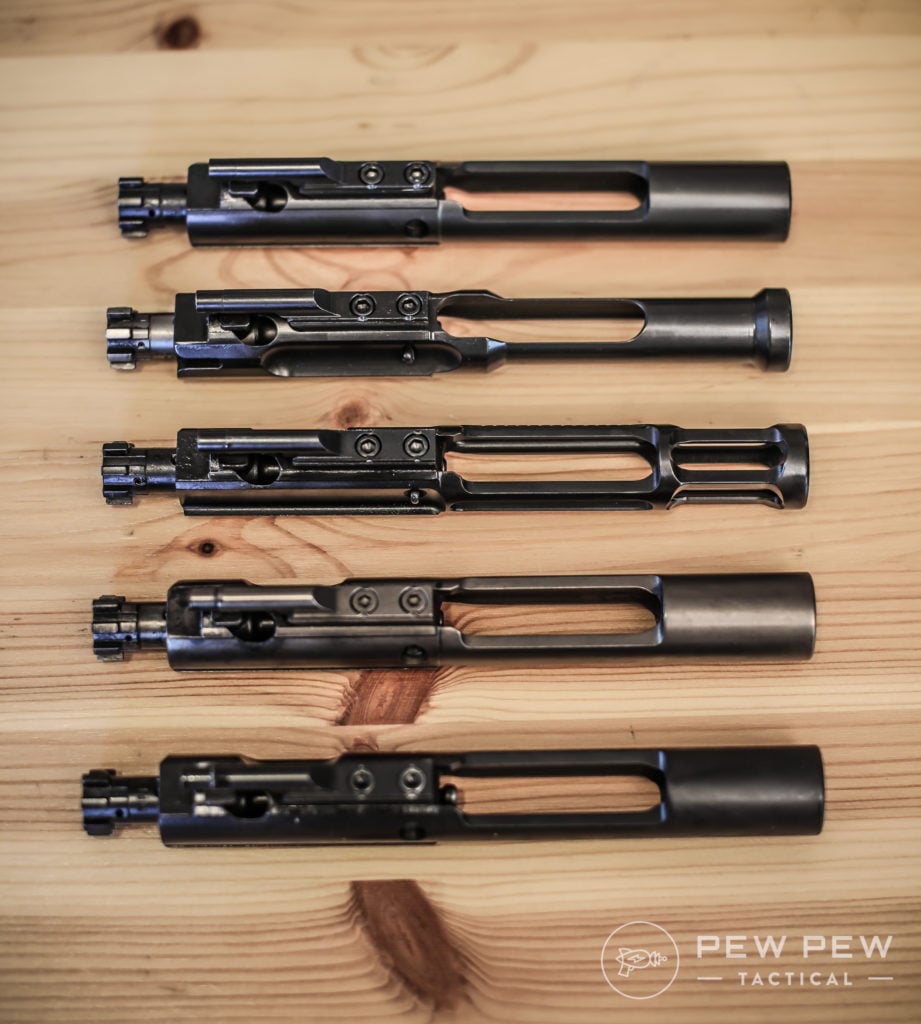
So there you have it…our list of the best lightweight BCG’s on the market right now.
Want more awesome AR-15 reviews and guides? Take a look at this!
If you have any questions about swapping your bolt carrier group out, how to choose a new one, or you just want to tell others how much better (or worse) you’re shooting with a low-mass BCG, be sure to let us know in the comments below!

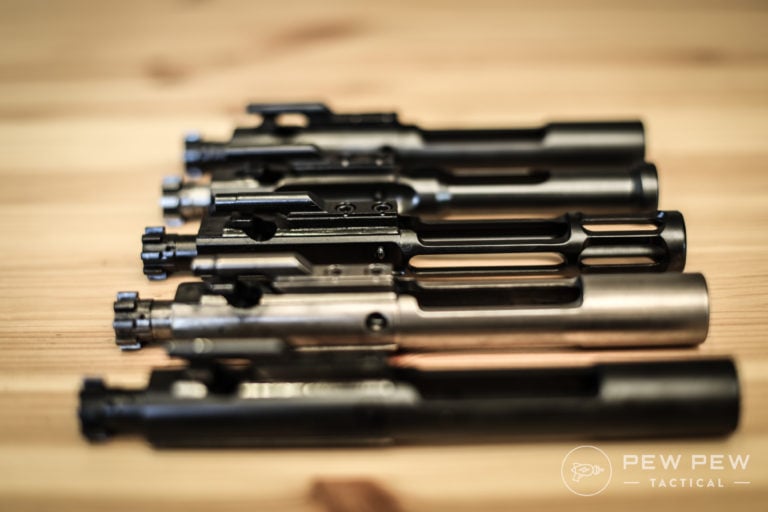
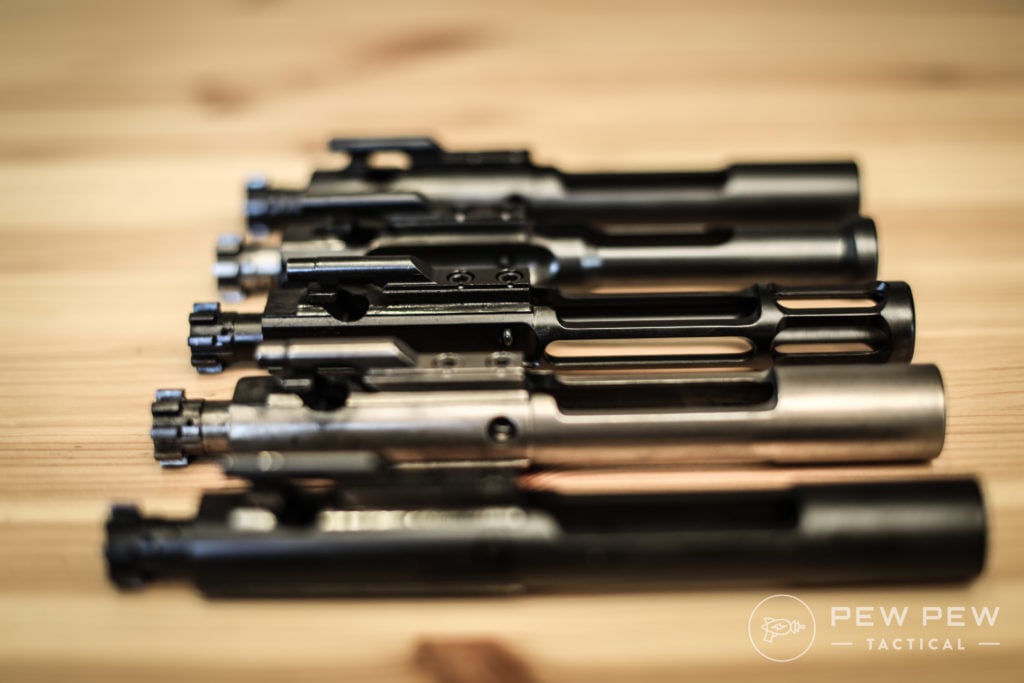
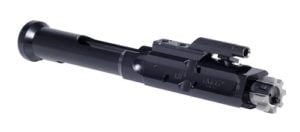
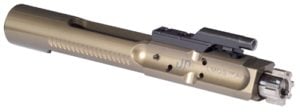

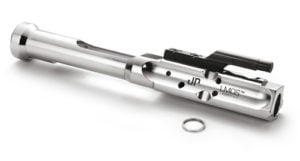


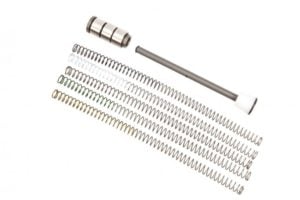








43 Leave a Reply
I have the faxon lightweight gunner 16” barrel paired with the lightweight faxon bcg. Can anyone make any sense out of accuracy issues with multiple brands of ammo? Additionally, the accuracy is slightly better with 5.56 ammo.
Why can't someone make a right side charging lightweight bolt carrier group for the 223/5.56 SBR's that want to make a cycling semi-auto w/ subsonic ammo. The pistol length gas system should be able to direct enough gas to operate it with the appropriate buffer spring/weight. The carbine and rifle length systems don't seem to direct enough gas to use for this. I have tried to contact BCA about making one, but can't get an answer.
I think you left out a few points, it can be very tricky to get these guns to run using superlight BCG, such as aluminum. I am using a superlative GB, bleed off style with 40 something adjustments. Even with that I was overgassed (suppressed), ended up with a restrictive Gas tube to get it to run. One click on the GB and it us over/under gassed. Furthermore aluminum BCGs, wear quickly, typically where the hammer interfaces to cock. Aluminum BCGs are really meant for competition. Also aluminum BCGs are available for $160.00, or where last time I checked. Not from JP, but quality nonetheless.
Thoughts on the Battle Arms Development Titanium BCG?
Hello will the same recommendations work for 308? And will anyone recommend do this for a 308? Thanks
The AR-10 requires a much larger BCG, they are not compatible in any way :( Some of these companies also make AR-10 BCGs, but I haven't ever used or seen a lightweight AR-10 BCG. Due to the increased power you're working with, I would strongly recommend sticking with a normal BCG for .308 Win.
Actually there are a few Lightweight/Low Mass/Titanium BCG's out there for the AR-10 / 7.62, but good luck finding any of them now lol. Rubber City Armory Does make a Titanium and a low mass steel version according to their website, but both are out of stock at this time (shocker hahaha)
I'm putting a 2A Armament Ti BCG in my newest build, which will be my first "how light can I make it" rifle. Cool thing is it's adjustable through the gas port, no adj gas block needed (which being able to adjust gas is pretty much a necesity once you start meddling with internals to this degree). I can't in good conscious tell you to buy one yet, literally is going together this weekend; but the reviews are good, and I ahve a bunch of their parts and receivers on other builds and they're top-shelf for sure. Writing this because they also make an adjustable Ti .308 BCG as well. FWIW the adjustable AR15 Ti BCG is 5.93oz complete, 48% less than the full mass I typically run. Just looked, and their 308 Ti adjustable is 11.55, about 32% less than a typical full mass (and ironically the same exact weight as a full mass ar15 BCG lol).
Just a little food for thought. People do it for sure. As others have said, it's not a dragon I'd chase on my first or second, "trust my life to it" rifle. But it's a fun experiment, and if you get running enough that it prooves itself to me/you, it could very well end up being that rifle (or, if nothing else, a great candidate to carry through the woods all day).
Thanks for the great input, I had not heard a bunch of information you presented in the building upper w low mass/wt BCG... I changed a barrel on an upper and no torque wrench, no shims/spacing devices, just kept tightening and it works, headspace was tight and was denting brass when I cycled before shot it. Got the go or no go? (Forgot which, have both now) so I would not blow myself up. Next one I will do right:)
Eric,
Your comments here indicate these lightweight setups are for competition guns.
Are they too unreliable or sensitive for a target rifle, hunting rifle or self defense rifle?
Thanks,
David
A lightweight BCG is great for a competition rifle that you're willing and able to give proper care and time in to, but I wouldn't put them in a hunting or self-defense rifle personally. Target rifle depends on what you're looking to get out of it.
Due to the design, these BCGs can be a little finicky across different types of ammo and the gas system may require retuning between different loads. It is also just naturally less durable than a full-weight BCG.
Thanks for the reply. It seems then the only option for a gun that may see some neglect would be a semi-auto bcg to save a little bit of weight.
Aluminum BCGs DO NOT necessarily have to have dramatically lower lifespans. Aluminum-on-aluminum is extremely high friction and wear. Yet, automobile engines have used aluminum pistons on aluminum cylinder blocks for half a century. Engines have cycles measured in thousands of RPMs, each of which represents two strokes of the pistons. This is with a crankshaft and rods slapping the pistons from side to side too, not a largely linear action like a BCG. The Secret?
--
IRON. The engines either have iron cylinder liners or they have an iron coating on the pistons themselves. TiN and all these "ultra hard" coatings are counter productive. The idea is to have the two surfaces have a low friction co-efficient. Sandpaper against sand paper wears even if sand is very hard. Lead-bronze against steel, not so much even though lead-bronze is NOT.
Aluminum engine blocks have plated cylinder walls. There is no aluminum on aluminum friction surface in the cylinder/piston interface.
Iron Coating on Pistons? I have no idea what you are talking about.
Coatings on internal engine components are standard procedure for many wear surfaces in production engines, and for virtually every wear surface in a modern competition engine. So your generalized statement about coatings is categorically and provably false.
Sandpaper vs. sandpaper, Bronze, vs. steel: I have no idea what point you are trying to make here. But there is a lot more to wear surface performance than hardness. Doubt me? Then why does an engine bearing have a babbitt surface so soft you can embed your figernail in it, yet can handle the loads generated by engines producing thousands of horsepower. In fact, hardness is one of the lesser factors. Surface characteristics, geometrical fitment, chemical interaction, temperature, lubrication, etc are what determine wear characteristics.
Its not the aluminum on aluminum or aluminum in a composite upper, its where the BCG slides over the hammer to cock. This area will wear quickly.
I have been running a Brownells lightweight BCG with an SLR adjustable gas block, and an Armaspec Stealth capture spring behind a midlength Faxon 14.5" pencil barrel, and with about 3000 rounds through it, I am pleased with this build's performance. Lightweight, yet little recoil or muzzle rise. These are definitely mods to be considered, for any type of build.
Eric
Looking for a left handed BCG group, light weight, NIb -556 and 6.5 grendel II
fallowed your page on light weight BCG's not alot out there in LH catagory. Young manufacturing has one that is chrome, but weight is at 10.
Bolts, I can buy if need be, its just the carrier .
Iron City Rifle works has a great looking line of RH BCGs but online page shows NO LH . need to call and ask if they can manufacture.
same with Young.
What our opion on ajustable gas keys vs ajustable blocks?
Question " Do you know of any compainies that I may have missed? Or is this a NO NO to ask that question due to "promoting". Thanks
FYI, the Brownells low mass BCG WILL NOT run in a milspec tube. I ordered one for a custom pistol build and i could not pull back the charging handle. I tried in my rifle and it would cycle manually but with a lot of resistance and would be afraid to fire it. Brownells tech said it is intended for competition guns using commercial tubes. From ordering, to getting a refund after it was returned, it took almost 2 months! Not one person told me the same thing the entire wait. I even had to have my bank file a dispute.
I have the Brownells Lightweight BCG and a milspec tube with a reduced power spring and it works just fine.
Being in Canada we have a lot of what you call SBRs, I am having issues with a 10in in 223. I admit I am using bargain NEA barrel, and BCG. I get double feeds and short stroking, stove piping, changed rings and drilled out gas port with some.. 50% improvement but still feel at a loss. Another gent with a 7,5in said he switched to a semi BCG and bingo, would a lighter BCG and better quality bolt with stronger springs help?
That's a hard question to answer without taking all parts of your specific gun into account. The type of gas port hole in your barrel, gas port, buffer weight and spring, and BCG all play a factor in how your gun will run. If you don't have an adjustable gas block i'd start there. What you will want to do is close the port all the way and back it out a bit. Then shoot one shot and continue to use more gas till the gun cycles. Once the gun cycles i'd put like 10 rounds through it to make sure everything is good. There are videos on how to work on the gas system of an AR on youtube, if you need more info i would start there.
Thanks for the reply. I like the idea with the gas Port. I will switch to a 11.5 in barrel or longer to eliminate short dwell time, i have had some success since we talked, switched to Winchester white box (much better) and coated gas rings in heavier oil.. oh gas rings gaps we're all aligned.... Ahhhh. Also coated BCG and upper in Teflon. That being said i am using bargain parts.
Eric, thank you for taking the time to share what you've learned. I am starting my first AR15 build, my first rifle in 25 years, and I've taken this info to heart.
Thanks again for your time.
Pew pew baby.
DQ
You should do a review on the Brownells reduced weight BCGs! All three flavors; and please cover reliability, wear, coating retention (for NiB and TiN), lubricity, rust endurance for the nitride version, and opinion/review on "how it feels", as well as how to best combine it with other parts to fully benefit from this BCG (buffer system, gas blocks, etc). If you can pull this off it would be great, thanks!
Links of other reviews on this also welcomed...Thanks again!
Yup, when we update the article we will get our hands on a few!
You say the price is 200 less than the jp aluminium on the faxon and it weighs less. The 1st part of that is correct the second is not i don't think. For the jp aluminum you say 5. something and the faxon 8. something.
In conjunction with the adjustable gas block, can a reduced buffer weight do the same thing as a reduced BCG? Essentially they are never separated. I'm just planning my steps for my competition 3G rifle.
I've seen them combined (JP has one) but not sure if it will achieve the same thing by itself.
buffer absorbs the bcg.. no not the same thing.. the mass of the bcg is felt recoil. the weight of buffer absorbs energy of kinetic mass.(bcg) .. very different things.
well I am a little late to reading the part about not building a light weight AR as my first build.
So far I have the Balios Lite Gen @ receiver set. Daniel Defense 5.56 16' light weight barrel.
Any suggestions on where I should go with this?
Can I Use the Balios lite for a regular weight set up. then change parts out as I get more familiar with it. Only thing I know about Ar's is what I have read in the last 2 days.
Thank you for any help.
The Balios should be good to go for whatever weight set up you're looking for. We have tons of AR info in our AR-15 section.
Thank you very much for the reply
why aren't any of the Bolts or Cam pins Titanium?
I have a whiskey arms Carrier (109 grams)
v seven ti firing pin ( 4.5 grams)
Nickel Boron Cam pin (7.5 grams)
and a nickel Boron Bolt (43.57 grams)
total weight 166 grams or 5.85 oz
would like to get it even lower for fun. Looking for the lightest most durable Bolt and cam pin to swap out. Not having any luck on finding weights on them or manufacturers of Titanium and i cant seem to find why. Also not opposed to a lighter retaining clip but that is silly.
I'm not too sure why, but that is a light setup you've got there!
Eric, you failed to mention the real reason aluminum BCGs wear like crazy. It is NOT because aluminum is softer. It is because Aluminum-on-Aluminum friction is murderously high. That is why in engineering making aluminum parts rub on aluminum parts is a no-no. The friction co-efficient between steel and steel is about 0.5 to 0.8. Between aluminum and steel is about 0.6. Between steel and bronze (commonly used in bearings) is about 0.2. Steel-Teflon is about 0.1. Aluminum-aluminum friction co-efficient is about 1.3 -- the highest of any commonly known and used material! It's murder!!!
That is why aluminum engine blocks use iron cylinder liners or a plasma coating of iron or some other material, so as to avoid making those aluminum pistons rub on aluminum cylinder walls. That is also why you should NEVER use an aluminum BCG on an aluminum receiver!
Thanks for the knowledge bombs, Dwight!
Anyone have experience with, or an educated opinion about, the 2A Armament Lightweight "Adjustable" ("Regulated") 5.56/300 BCG? At least theoretically, on its own it is supposed to provide both the benefits of an adjustable gas block and lightweight BCG. THANKS
Thanks for the info, wish you could have included the Aim Surplus and Anderson Manufacturing lightweight BCG options.
I enjoy this write up, but it seems limited to competition guns. Moreover, doesn't it make sense that if you wanted fast follow up shots that more mass + tuning the gas and buffer would result in the fastest BCG reset?
I can understand this set up for 3-gun racing though where recoil + follow-up would be the idea.
Yup, it's pretty much limited to competition guns. Your scenario might result in faster reset but like you said...the recoil/follow-up might be affected.
Excellent article on low mass bcg's as with all your articles,very informative
I wouldnt go this route for a first build but once you are familiar with how everything on your AR works go for it and like the article says you will need to change buffer tube springs and get an adjustable gas block.
Yup...I'd wait until maybe the third!